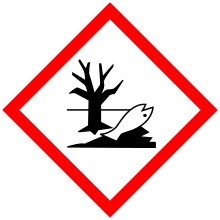Environmental hazard

An environmental hazard is a substance, state or event which has the potential to threaten the surrounding natural environment and / or adversely affect people's health. This term incorporates topics like pollution and natural disasters such as storms and earthquakes.
Human-made hazards while not immediately health-threatening may turn out detrimental to man's well-being eventually, because deterioration in the environment can produce secondary, unwanted negative effects on the human ecosphere. The effects of water pollution may not be immediately visible because of a sewage system that helps drain off toxic substances. If those substances turn out to be persistent (e.g. persistent organic pollutant), however, they will literally be fed back to their producers via the food chain: plankton -> edible fish -> humans. In that respect, a considerable number of environmental hazards listed below are man-made (anthropogenic) hazards.
Hazards can be categorized in four types:
- Chemical
- Physical (mechanical, etc.)
- Biological
- Psychosocial
Chemical
Chemical hazards are defined in the Globally Harmonized System and in the European Union chemical regulations. They are caused by chemical substances causing significant damage to the environment. The label is particularly applicable towards substances with aquatic toxicity. An example is zinc oxide, a common paint pigment, which is extremely toxic to aquatic life.
Toxicity or other hazards do not imply an environmental hazard, because elimination by sunlight (photolysis), water (hydrolysis) or organisms (biological elimination) neutralizes many reactive or poisonous substances. Persistence towards these elimination mechanisms combined with toxicity gives the substance the ability to do damage in the long term. Also, the lack of immediate human toxicity does not mean the substance is environmentally nonhazardous. For example, tanker truck-sized spills of substances such as milk can cause a lot of damage in the local aquatic ecosystems: the added biological oxygen demand causes rapid eutrophication, leading to anoxic conditions in the water body.
All hazards in this category are mainly anthropogenic although there exist a number of natural carcinogens and chemical elements like radon and lead may turn up in health-critical concentrations in the natural environment:
- Anthrax
- Antibiotic agents in animals destined for human consumption
- Arsenic - a contaminant of fresh water sources (water wells)
- Asbestos - carcinogenic
- DDT
- Carcinogens
- dioxins
- Endocrine disruptors
- Explosive material
- Fungicides
- Furans
- Haloalkanes
- Heavy metals
- Herbicides
- Hormones in animals destined for human consumption
- Lead in paint
- Marine debris
- mercury
- Mutagens
- Pesticides
- Polychlorinated biphenyls
- Radon and other natural sources of radioactivity
- Soil pollution
- Tobacco smoking
- Toxic waste
Physical
- Cosmic rays
- Drought
- Earthquake
- Electromagnetic fields
- E-waste
- Floods
- Fog
- Light pollution
- Lighting
- Lightning
- Noise pollution
- Quicksand
- Ultraviolet light
- vibration
- X-rays
Biological
- Allergies
- Arbovirus
- Avian influenza
- Bovine spongiform encephalopathy (BSE)
- Cholera
- Ebola
- Epidemics
- Food poisoning
- Malaria
- Molds
- Onchocerciasis (river blindness)
- Pandemics
- Pathogens
- Pollen for allergic people
- Rabies
- Severe acute respiratory syndrome (SARS)
- Sick building syndrome